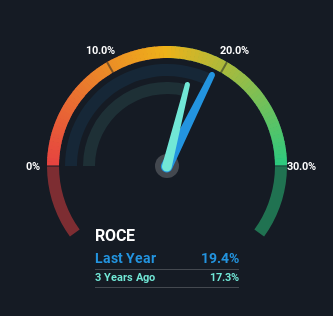Epigral (NSE:EPIGRAL) Might Be Having Difficulty Using Its Capital Effectively
To find a multi-bagger stock, what are the underlying trends we should look for in a business? Ideally, a business will show two trends; firstly a growing return on capital employed (ROCE) and secondly, an increasing amount of capital employed. Put simply, these types of businesses are compounding machines, meaning they are continually reinvesting their earnings at ever-higher rates of return. In light of that, when we looked at Epigral (NSE:EPIGRAL) and its ROCE trend, we weren't exactly thrilled.
What Is Return On Capital Employed (ROCE)?
If you haven't worked with ROCE before, it measures the 'return' (pre-tax profit) a company generates from capital employed in its business. The formula for this calculation on Epigral is:
Return on Capital Employed = Earnings Before Interest and Tax (EBIT) ÷ (Total Assets - Current Liabilities)
0.19 = ₹3.6b ÷ (₹26b - ₹7.9b) (Based on the trailing twelve months to December 2023).
Therefore, Epigral has an ROCE of 19%. On its own, that's a standard return, however it's much better than the 14% generated by the Chemicals industry.
View our latest analysis for Epigral

In the above chart we have measured Epigral's prior ROCE against its prior performance, but the future is arguably more important. If you're interested, you can view the analysts predictions in our free analyst report for Epigral .
What Does the ROCE Trend For Epigral Tell Us?
When we looked at the ROCE trend at Epigral, we didn't gain much confidence. Around five years ago the returns on capital were 35%, but since then they've fallen to 19%. However it looks like Epigral might be reinvesting for long term growth because while capital employed has increased, the company's sales haven't changed much in the last 12 months. It may take some time before the company starts to see any change in earnings from these investments.
On a side note, Epigral's current liabilities have increased over the last five years to 30% of total assets, effectively distorting the ROCE to some degree. Without this increase, it's likely that ROCE would be even lower than 19%. Keep an eye on this ratio, because the business could encounter some new risks if this metric gets too high.
In Conclusion...
Bringing it all together, while we're somewhat encouraged by Epigral's reinvestment in its own business, we're aware that returns are shrinking. Although the market must be expecting these trends to improve because the stock has gained 9.4% over the last year. But if the trajectory of these underlying trends continue, we think the likelihood of it being a multi-bagger from here isn't high.
On a separate note, we've found 3 warning signs for Epigral you'll probably want to know about.
If you want to search for solid companies with great earnings, check out this free list of companies with good balance sheets and impressive returns on equity.
Valuation is complex, but we're here to simplify it.
Discover if Epigral might be undervalued or overvalued with our detailed analysis, featuring fair value estimates, potential risks, dividends, insider trades, and its financial condition.
Access Free AnalysisHave feedback on this article? Concerned about the content? Get in touch with us directly. Alternatively, email editorial-team (at) simplywallst.com.
This article by Simply Wall St is general in nature. We provide commentary based on historical data and analyst forecasts only using an unbiased methodology and our articles are not intended to be financial advice. It does not constitute a recommendation to buy or sell any stock, and does not take account of your objectives, or your financial situation. We aim to bring you long-term focused analysis driven by fundamental data. Note that our analysis may not factor in the latest price-sensitive company announcements or qualitative material. Simply Wall St has no position in any stocks mentioned.
About NSEI:EPIGRAL
Epigral
Manufactures and sells chlor-alkali and related derivatives in India and internationally.
Flawless balance sheet with high growth potential.
Similar Companies
Market Insights
Community Narratives




